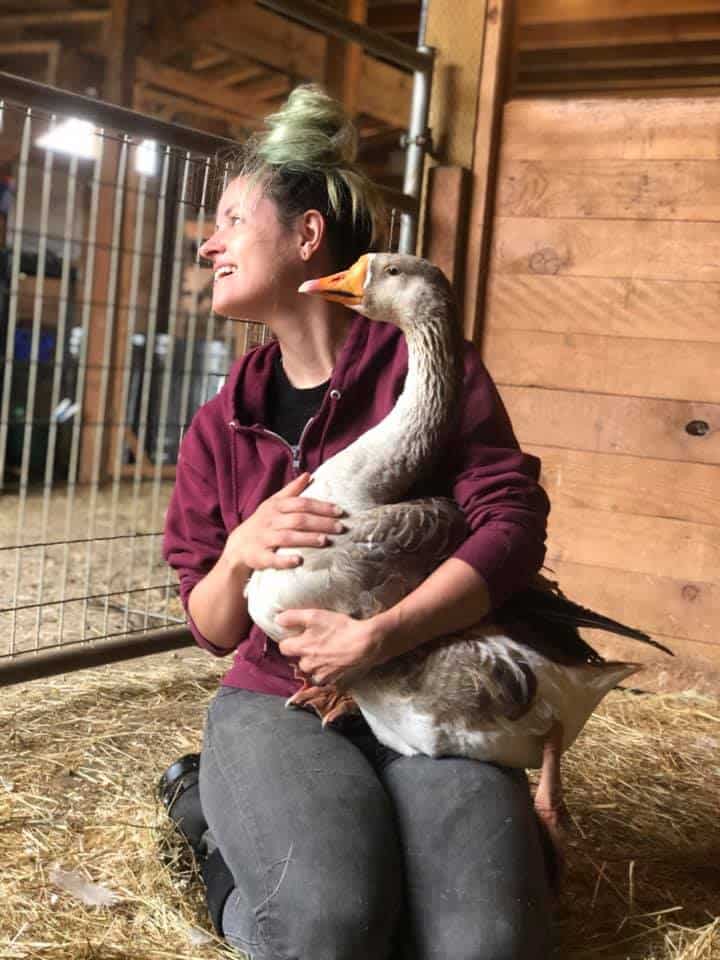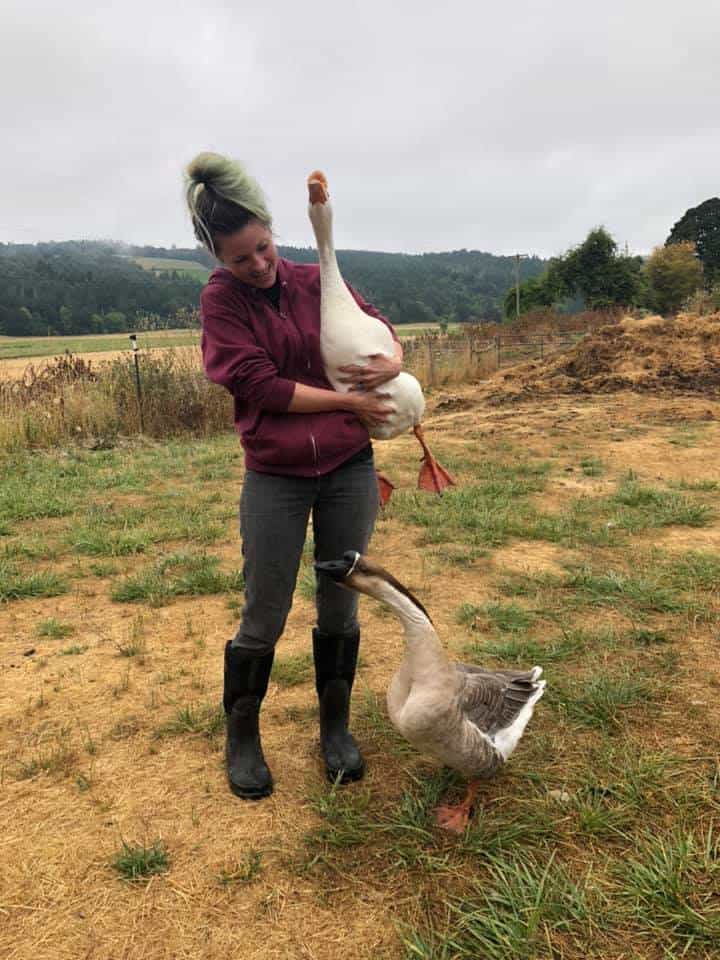
Updated September 4, 2020
If you’re caring for geese, it’s very important that you know how to safely handle and hold each of them. Some geese are more receptive to being held than others, but many geese aren’t very fond of the experience. Each resident in your care might have their own special handling requirements depending on their breed and health needs. Regularly picking up a goose will help familiarize them with the experience and can help make stressful events like health concerns, separations, and relocations a little less nerve-wracking.
If at all possible, have a veterinarian or care expert give you hands-on training for safe gooseUnless explicitly mentioned, we are referring to domesticated goose breeds, not wild geese, who may have unique needs not covered by this resource. handling! Failing to use appropriate technique can gravely injure geeseUnless explicitly mentioned, we are referring to domesticated goose breeds, not wild geese, who may have unique needs not covered by this resource..
The Approach
When approaching a goose, it’s essential that you do not chase them. Chasing is going to stress them out and will likely make them skittish around you. Lowering yourself down to their level and offering a little bit of feed or a treat can help encourage geese to want to spend time with you! Some more nervous geese may actively avoid your grip, so they might require a bit more coaxing. If you’re gathering a goose for a health checkup, especially if they are showing signs of illness, remember to wear gloves and protective clothing in order to lower the chances of contracting or spreading any external parasites. And even if you aren’t conducting a health examination, you may want to wear thicker clothing and gloves when handling more skittish geese, because they may nip at you, scratch you, or strike you with their powerful wings when you try to handle them.
The Pickup
Gently corral the goose into a corner before you attempt to pick them up. When you are near enough, you can either place one hand on each side of their body, keeping their wings against them, or place one hand in front of their chest to prevent them from moving forward and then place one hand on their back to keep them still. Once the goose is still, you can either place both hands securely over both wings and partially around their body or, for larger geese, it may be easier to lift them if you wrap one arm around them so that your hand can support their keel while your arm holds their wing in place. You can then lift them towards you so that one side is held firmly against your body. This will free up one of your hands, which you can place under their body to help support them. It’s okay if their legs are free (and some geese actually prefer this) as long as you have their wings secured and their body safely cradled. Be prepared to put them down if they start to struggle or if they get a wing free. This will prevent them from injuring themselves or jumping away from you. It’s not safe to hold a goose’s body under their wings because of the risk of injury. Do not lift them off their feet until they are calmly controlled on the ground!
For larger geese and those who have compromised health, some may be too large, too fragile, or have too much strain on their respiratory system to ever safely lift them off the ground. Instead, you should sit cross-legged near the goose and then hug them safely into your lap, securing their wings. You must be extraordinarily cautious when it comes to handling and rotating these birds, as it could cause serious bodily harmThe infliction of mental, emotional, and/or physical pain, suffering, or loss. Harm can occur intentionally or unintentionally and directly or indirectly. Someone can intentionally cause direct harm (e.g., punitively cutting a sheep's skin while shearing them) or unintentionally cause direct harm (e.g., your hand slips while shearing a sheep, causing an accidental wound on their skin). Likewise, someone can intentionally cause indirect harm (e.g., selling socks made from a sanctuary resident's wool and encouraging folks who purchase them to buy more products made from the wool of farmed sheep) or unintentionally cause indirect harm (e.g., selling socks made from a sanctuary resident's wool, which inadvertently perpetuates the idea that it is ok to commodify sheep for their wool). to them. Some birds can never be safely rotated onto their side or back.
NEVER pick up a goose by their wings, feathers, legs, feet, or neck. This is an extremely unsafe and unacceptable practice that regularly harms geese. Do not allow anyone else to pick them up by their wings either! Some veterinarians have been known to do this as it is a standard practice in animal agriculture environments.
Once safely in your grip, you can gently petAn animal who spends regular time with humans in their home and life for companionship or human pleasure. Typically a small subset of animal species are considered to be pets by the general public. them (never stroking against their feather grain!) and talk to them softly in order to calm them down and make them more comfortable with human handling. There’s an optimal balance to be struck between holding them firmly, but not causing them injury. You always want the bird to be calm, not gasping or struggling under pressure, and feeling confident they aren’t going to fall. If a goose is simply too stressed out to be held and rapidly, or open mouth breathing, you must set them down and let them calm down.
If you need to check a goose’s vent area, such as for external parasites, you can gently rotate them onto their side while in your lap (watching for any signs of distress) or you can even have them sit or stand upright in your lap. In these positions, you should be able to bend towards their backside to take a peek. If this is not possible for some reason, you can have another caregiver take note of their rear end while keeping them secured and comfortable.
Geese have much more fragile feet and legs than chickens, so be extra mindful of them when handling! Never let them jump away from you if they’re high up.
Picking Up A Skittish Goose
If a goose is fearful or confrontational, it can be better to approach and pick up the goose from behind, to keep their head a safe distance from your face. Geese have been known to nip at whatever’s closest, and a nip on the nose is not a pleasant experience for anyone involved! For these fearful or confrontational geese, rather than coming from a low angle, it’s better to approach them standing up with a straight back to prevent the likelihood that they’ll strike at you. In some cases, you may need to use one of your hands to gently prevent them from getting close enough to bite you. With some individuals it can be helpful to have another set of hands available.
Carrying A Goose

To carry the goose, keep one hand securely under their keel. If they aren’t pleased to be carried, you can gently keep a hand near their neck or head to limit their range of motion, but you shouldn’t forcefully restrain their neck as it could very seriously injure them. You should always watch for any signs of distress, but it is especially important to pay extra attention to larger or health-compromised geese who may be more likely to have an adverse reaction to handing. These individuals should only be handled when absolutely necessary, and if moving them more than a very short distance, in many cases it will be less stressful to move them by placing them in an animal carrier rather than carrying them.
Setting Down A Goose
When you set down a goose, safely and carefully let their feet back onto the ground while continuing to keep their wings secure until you’re confident that they will gently leave you. Never let a goose jump down! Consider giving them a diet-appropriate treat after handling so they have a positive memory to associate the experience with.
At The Open Sanctuary Project, unacceptable means that we cannot condone (or condone through omission) a certain practice, standard, or policy. See a more detailed explanation here.
SOURCES:
Catching & Handling Waterfowl | Majestic Waterfowl
How Do I Pick Up A Goose? | My Pet Chicken (Non-Compassionate Source)
If a source includes the (Non-Compassionate Source) tag, it means that we do not endorse that particular source’s views about animals, even if some of their insights are valuable from a care perspective. See a more detailed explanation here.








